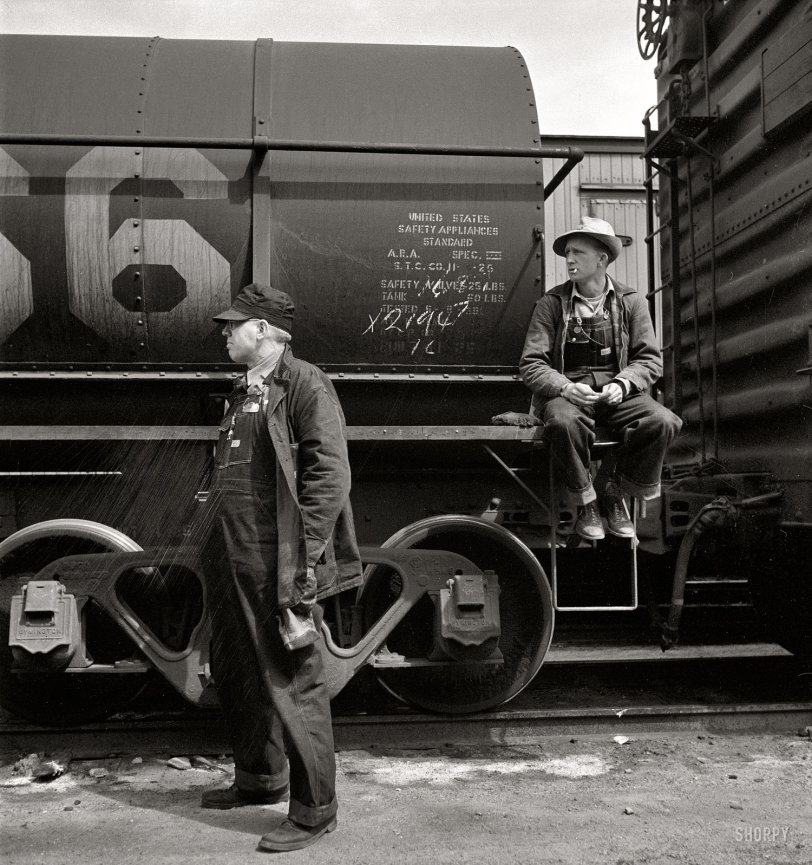


Framed or unframed, desk size to sofa size, printed by us in Arizona and Alabama since 2007. Explore now.
Shorpy is funded by you. Patreon contributors get an ad-free experience.
Learn more.

- Freeze Frame
- Texas Flyer wanted
- Just a Year Too Soon
- WWII -- Replacing men with women at the railroad crossing.
- Yes, Icing
- You kids drive me nuts!
- NOT An Easy Job
- I wonder
- Just add window boxes
- Icing Platform?
- Indiana Harbor Belt abides
- Freezing haze
- Corrections (for those who care)
- C&NW at Nelson
- Fallen Flags
- A dangerous job made worse
- Water Stop
- Passenger trains have right of way over freights?
- Coal
- Never ceases to amaze me.
- Still chuggin' (in model form)
- Great shot
- Westerly Breeze
- For the men, a trapeze
- Tickled
- Sense of loneliness ...
- 2 cents
- Charm City
- What an Outrage
- Brighton Park
Print Emporium
Ready to Roll: 1943

March 1943. Barstow, California. "Head brakeman J.C. Shannon (left) and swing brakeman B.E. Wilson waiting for their train to pull out of the Atchison, Topeka and Santa Fe yard." Nitrate negative by Jack Delano. View full size.
Graffiti
Gee, where is all the "beautiful" spray-can artwork that adorns out present-day rail stock? Although I am an artist, I can't stand this vandalism. Not only a waste of paint, but detrimental to the environment. The photo looks like source material for one of Norman Rockwell's cover projects.
Brakeman in 1943?
KC Ry.,
Your account of a brakeman is accurate, in the days before Westinghouse Air Brakes, pre-1893. In the photo I see brake shoes on the tank car, and an air line between the cars.
Q - What then was the role of a Brakeman in 1943? Setting of brakes when cars were uncoupled?
Jack Delano RR photos are always enjoyable.
Initials
Perhaps one of you old railroaders could refresh my memory on this. Several years ago my daughter bought me a wonderful coffee table photo book that was comprised of all night photos of steam trains in Virginia (I believe). In the book they noted the tradition of railroaders using initials instead of names. Thoughts?
[Possibly O. Winston Link's Ghost Trains or Steam Steel and Stars]
Yes, I believe that it is indeed Steam, Steel, and Stars!
A moments respite
As a former yard brakeman, this brings back the memories of a few quiet moments waiting for someone else to do their work and get out of our way. That tank car was not only a nice place to sit, but it had a two step stirrup with a high running board, making it a much easier car to get on of off than many tanks and flats. The Nickel Plate Road safety officer always discouraged our trying to get on or off this type of car while it was in motion. Maybe that little advice contributed to our being a Harriman Safety Award winner so often.
Since the air hoses between the tank and box car are not connected, there is still some work to do before this cut becomes part of a train. But the guys shown here certainly have the wherewithal to assemble it.
Life imitating art?
That could be a still from a movie starring the young Spencer Tracy and Charles something (I keep forgetting the name).
[Bickford? Laughton? Ruggles? Butterworth?]
Charles Laughton, I think. Thanks for the pointers!
The Wheels Were Always Waiting.
These guys were tough!
Getting on one of those tanks on the move at night in the rain, sleet or blowing snow by the light of a coal oil lamp was a challenge.
Sort of a grasping leap in harmony with the moving train. Footing impeded with sloped ballast edge or deep snow while carrying the lamp, which would go 'out' if roughly handled.
You had only one chance! on a moving tank.
If your boot heel slipped beyond the stirrup you could feel the wheel rubbing against it just waiting to carve you to bits if your hands slipped and you pivoted under and fell.
Flat cars were worse to board, with less to grab.
The Engineer could never stop in time, if he even saw you slip and fall far back in the train, the tonnage pushing.
No radios, then.
If you had to 'walk' the top of the train to relay hand signals, set up or take down retainers or apply hand brakes, when required by whistle signal, you climbed down to the tanks from the boxcars and went around the outside of the tank on the wooden running board holding on to the hand rail pipe at speed.
The tops of the high cars rocked back and forth sideways in answer to the staggered rail joints under the wheels, and it was often better to run than walk, jumping car-to-car, with a long fall to the waiting wheels below.
Ice and snow made this a challenge, rain too, or if the catwalks were slippy with oil from an oil-fired engine or a new Diesel's exhaust.
Too old to go back, and glad of it.
Thank You.
























On Shorpy:
Today’s Top 5